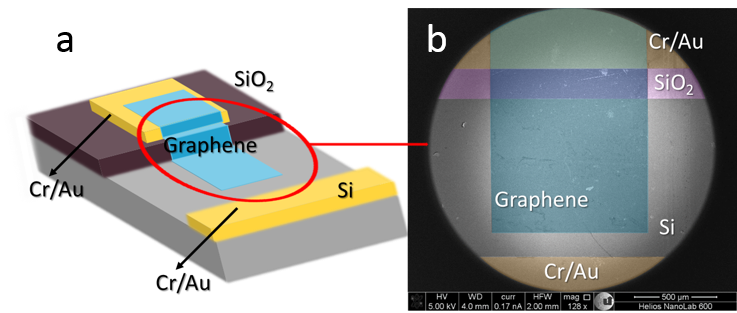Abstract—We have studied the optical properties of two-dimensional (2D) Schottky photodiode heterojunctions made of chemical vapor deposited (CVD) graphene on n- and p-type Silicon (Si) substrates. Much better rectification behavior is observed from the diodes fabricated on n- Si substrates in comparison with the devices on p-Si substrates in dark condition. Also, graphene – n-Si photodiodes show a considerable responsivity of 270 mAW-1 within the silicon spectral range in DC reverse bias condition. The present results are furthermore compared with that of a molybdenum disulfide (MoS2) – p-type silicon photodiodes.
Molybdenum-disulfide (MoS2), a layered transition metal dichalcogenide (TMD), is an important member in the family of two-dimensional (2D) materials. In contrast to graphene, MoS2 is a semiconductor and its bandgap varies depending on the number of the layers. Therefore, MoS2 has the possibility to detect light at different wavelengths. Monolayer MoS2 has a direct bandgap of ~1.8 eV, while bulk MoS2 has an indirect bandgap of ~1.3 eV. In addition, MoS2 has high transparency and mechanical flexibility and it is easy to process . All of these exceptional properties make MoS2 another promising material for electronic and optoelectronic applications.
In this work, we report on CVD graphene-based Schottky barrier photodiodes of simple architecture ,which are also scalable, reproducible and of low-cost. To fabricate the diodes, we have adopted a similar process as in, where large area CVD-grown graphene films were transferred onto pre-patterned nand p-type Si-substrates. Afterwards, we performed electrical and optical characterizations on the photodiodes. The optical data obtained from the measurements are further compared to that of MoS2 – p-type silicon photodiodes, which have been presented in detail in our previous work.
Electrical measurements on the diodes were performed on a Karl Süss probe station connected to a Keithley semiconductor analyzer (SCS4200) under ambient conditions. The voltage for all devices was swept from 0 to +2 V for forward and from 0 to -2 V for reverse biasing. A white light source (50 W halogen lamp) with a dimmer to control the light intensity was used to measure the photoconductivity of the diodes. The variable incident light intensity has been modulated between 0 and 3 mWcm-2 . A CA 2 laboratory thermopile was used to measure the intensity of the light source.

Fig1
Henceforth, further measurements in this work were performed on the graphene – n-Si diodes. The forward J-V characteristic of the diode can be described by the single-exponential Shockley equation [30] allowing the extraction of the ideality factor and the Schottky barrier height (SBH). The ideality factor, the Schottky barrier height (SBH) and the series resistance of 1.52 ± 0.1, 0.65 ± 0.08 eV and 7.5 ± 0.7 kΩ, respectively, were extracted for the diodes in Fig. 3a. The extraction method is described in detail in [31]. The corresponding energy band diagrams for graphene – n-Si and p-Si diodes at zero bias voltage in the dark is shown in Fig. 3c and 3d, respectively.
Graphene based Schottky barrier photodiodes were fabricated using a simple, scalable and reproducible technology. We observed that diodes fabricated on an n-Si substrate exhibit a rectifying behavior, whereas the devices fabricated on a p-type Si substrate act as photoresistors. This behavior can be attributed to p-type graphene-doping due to its exposure to the ambient atmosphere leading to a higher Schottky barrier to the ntype silicon. Graphene – n-Si diodes exhibit a broad SR with responsivity up to 270 mAW-1 . Nevertheless, the main photoexcitation takes place in the n-type Si substrate due to low optical absorption by single layer graphene. Unlike in graphene-based diodes, the SR is limited to the band structure of MoS2 in the MoS2based photodiodes. This study promotes SR measurements as an excellent tool to probe the electronic properties of novel 2D-materials.
上一篇: 高温预退火对CZ硅片氧沉淀影响的研究
下一篇: 用硅光子纳米力学界面转换微波和电信光子